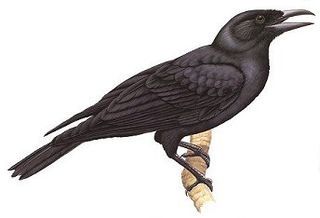
The Mariana crow is a species of the crow family from the tropical Western Pacific. It is a glossy black bird about 15 inches (38 cm) long and known only from the islands of Guam and Rota.
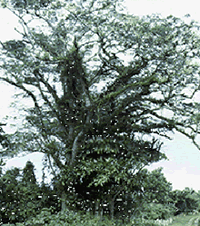
Serianthes nelsonii is a large tree endemic to Guam and Rota of the Mariana Islands. Only one mature tree existed on Guam, while 121 mature trees have been identified on Rota since 1984.
The Mariana swiftlet or Guam swiftlet is a species of swiftlet in the family Apodidae.

Partula faba, commonly known as the bean snail, Partula snail, or Captain Cook's bean snail, is an extinct species of air-breathing tropical land snail, a terrestrial pulmonate gastropod mollusk in the family Partulidae. This species was endemic to Ra'iātea and Tahaa, neighbouring islands which share the same lagoon, in French Polynesia. The species was the first Partula to be recorded.
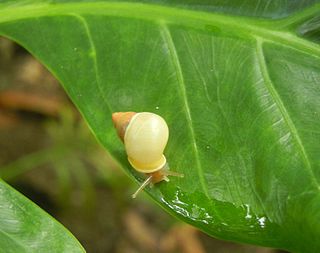
The fat Guam partula or humped tree snail, scientific name Partula gibba, is an endangered species of air-breathing land snail, a terrestrial gastropod mollusk in the family Partulidae.

Partula langfordi was a species of air-breathing land snail, a terrestrial pulmonate gastropod mollusk in the family Partulidae. This species was known by the common name Langford's tree snail and endemic to the Northern Mariana Islands. It was recently declared extinct by the International Union for Conservation of Nature in June of 2024.
Partula mirabilis, common name the Moorean viviparous tree snail, is a species of air-breathing tropical land snail, a terrestrial pulmonate gastropod mollusk in the family Partulidae. This species was endemic to the island of Moorea, French Polynesia. It is now extinct in the wild.

Partula mooreana, common name the Moorean viviparous tree snail, is a species of air-breathing tropical land snail, a terrestrial pulmonate gastropod mollusk in the family Partulidae. This species was endemic to French Polynesia. It is now extinct in the wild.
Partula nodosa, commonly known as the Polynesian tree snail, is a species of air-breathing tropical land snail, a terrestrial pulmonate gastropod mollusk in the family Partulidae.

Partula rosea is a species of air-breathing tropical land snail, a terrestrial pulmonate gastropod mollusk in the family Partulidae.

Partula suturalis, commonly called the moorean viviparous tree snail or the sutural partula, is a species of air-breathing tropical land snail, a terrestrial pulmonate gastropod mollusk in the family Partulidae. This species was endemic to the island of Moorea, French Polynesia. It is now extinct in the wild. It was previously listed as extinct in the IUCN Red List of Threatened Species, but has been moved to extinct in the wild since 2009. This error was the result of changing taxonomy.

Partula taeniata, common name the Moorean viviparous tree snail, is a species of terrestrial gastropod in the Partulidae family. It is endemic to French Polynesia.
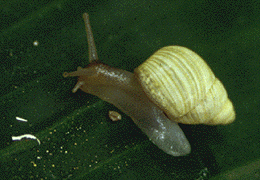
Partulidae is a family of air-breathing land snails, terrestrial gastropod mollusks in the superfamily Pupilloidea.
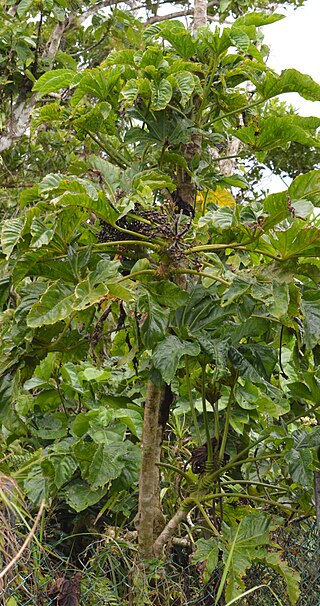
Osmoxylon mariannense is a rare species of tree in the family Araliaceae. It is endemic to Rota, one of the Northern Mariana Islands. A 2002 survey found only eight mature trees remaining on the island. A resident of the commonwealth, the tree is federally listed as an endangered species of the United States.

Partula is a genus of air-breathing tropical land snails, terrestrial pulmonate gastropod mollusks in the family Partulidae.
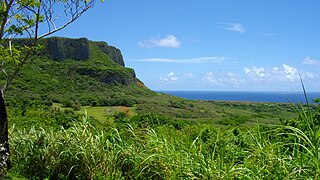
The Marianas tropical dry forests is a tropical and subtropical dry broadleaf forests ecoregion on the Marianas Islands in the western Pacific Ocean.

Michael Gale Hadfield is an invertebrate biologist and professor emeritus at the University of Hawaiʻi at Mānoa. His research has focused on the larvae of marine invertebrates and native tree snails in Hawai'i. He retired in 2013, but has remained active in research and was recognized in 2023 as one of the top ecology and evolutionary scientists in the U.S. and the world.














